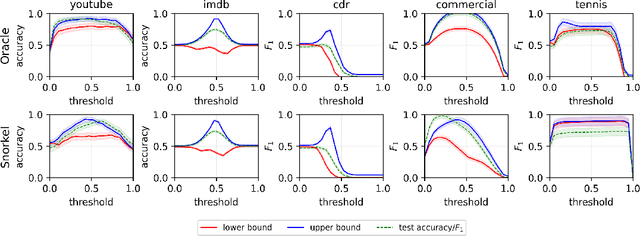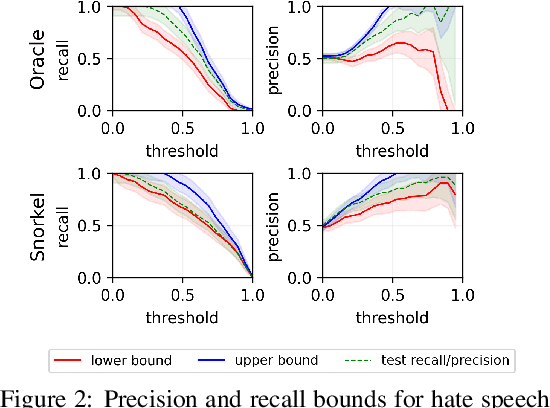Felipe Maia Polo
CARROT: A Cost Aware Rate Optimal Router
Feb 05, 2025



Abstract:With the rapid growth in the number of Large Language Models (LLMs), there has been a recent interest in LLM routing, or directing queries to the cheapest LLM that can deliver a suitable response. Following this line of work, we introduce CARROT, a Cost AwaRe Rate Optimal rouTer that can select models based on any desired trade-off between performance and cost. Given a query, CARROT selects a model based on estimates of models' cost and performance. Its simplicity lends CARROT computational efficiency, while our theoretical analysis demonstrates minimax rate-optimality in its routing performance. Alongside CARROT, we also introduce the Smart Price-aware Routing (SPROUT) dataset to facilitate routing on a wide spectrum of queries with the latest state-of-the-art LLMs. Using SPROUT and prior benchmarks such as Routerbench and open-LLM-leaderboard-v2 we empirically validate CARROT's performance against several alternative routers.
Sloth: scaling laws for LLM skills to predict multi-benchmark performance across families
Dec 09, 2024Abstract:Scaling laws for large language models (LLMs) predict model performance based on parameters like size and training data. However, differences in training configurations and data processing across model families lead to significant variations in benchmark performance, making it difficult for a single scaling law to generalize across all LLMs. On the other hand, training family-specific scaling laws requires training models of varying sizes for every family. In this work, we propose Skills Scaling Laws (SSLaws, pronounced as Sloth), a novel scaling law that leverages publicly available benchmark data and assumes LLM performance is driven by low-dimensional latent skills, such as reasoning and instruction following. These latent skills are influenced by computational resources like model size and training tokens but with varying efficiencies across model families. Sloth exploits correlations across benchmarks to provide more accurate and interpretable predictions while alleviating the need to train multiple LLMs per family. We present both theoretical results on parameter identification and empirical evaluations on 12 prominent benchmarks, from Open LLM Leaderboard v1/v2, demonstrating that Sloth predicts LLM performance efficiently and offers insights into scaling behaviors for downstream tasks such as coding and emotional intelligence applications.
Microfoundation Inference for Strategic Prediction
Nov 13, 2024



Abstract:Often in prediction tasks, the predictive model itself can influence the distribution of the target variable, a phenomenon termed performative prediction. Generally, this influence stems from strategic actions taken by stakeholders with a vested interest in predictive models. A key challenge that hinders the widespread adaptation of performative prediction in machine learning is that practitioners are generally unaware of the social impacts of their predictions. To address this gap, we propose a methodology for learning the distribution map that encapsulates the long-term impacts of predictive models on the population. Specifically, we model agents' responses as a cost-adjusted utility maximization problem and propose estimates for said cost. Our approach leverages optimal transport to align pre-model exposure (ex ante) and post-model exposure (ex post) distributions. We provide a rate of convergence for this proposed estimate and assess its quality through empirical demonstrations on a credit-scoring dataset.
LiveXiv -- A Multi-Modal Live Benchmark Based on Arxiv Papers Content
Oct 15, 2024Abstract:The large-scale training of multi-modal models on data scraped from the web has shown outstanding utility in infusing these models with the required world knowledge to perform effectively on multiple downstream tasks. However, one downside of scraping data from the web can be the potential sacrifice of the benchmarks on which the abilities of these models are often evaluated. To safeguard against test data contamination and to truly test the abilities of these foundation models we propose LiveXiv: A scalable evolving live benchmark based on scientific ArXiv papers. LiveXiv accesses domain-specific manuscripts at any given timestamp and proposes to automatically generate visual question-answer pairs (VQA). This is done without any human-in-the-loop, using the multi-modal content in the manuscripts, like graphs, charts, and tables. Moreover, we introduce an efficient evaluation approach that estimates the performance of all models on the evolving benchmark using evaluations of only a subset of models. This significantly reduces the overall evaluation cost. We benchmark multiple open and proprietary Large Multi-modal Models (LMMs) on the first version of our benchmark, showing its challenging nature and exposing the models true abilities, avoiding contamination. Lastly, in our commitment to high quality, we have collected and evaluated a manually verified subset. By comparing its overall results to our automatic annotations, we have found that the performance variance is indeed minimal (<2.5%). Our dataset is available online on HuggingFace, and our code will be available here.
Efficient multi-prompt evaluation of LLMs
May 27, 2024



Abstract:Most popular benchmarks for comparing LLMs rely on a limited set of prompt templates, which may not fully capture the LLMs' abilities and can affect the reproducibility of results on leaderboards. Many recent works empirically verify prompt sensitivity and advocate for changes in LLM evaluation. In this paper, we consider the problem of estimating the performance distribution across many prompt variants instead of finding a single prompt to evaluate with. We introduce PromptEval, a method for estimating performance across a large set of prompts borrowing strength across prompts and examples to produce accurate estimates under practical evaluation budgets. The resulting distribution can be used to obtain performance quantiles to construct various robust performance metrics (e.g., top 95% quantile or median). We prove that PromptEval consistently estimates the performance distribution and demonstrate its efficacy empirically on three prominent LLM benchmarks: MMLU, BIG-bench Hard, and LMentry. For example, PromptEval can accurately estimate performance quantiles across 100 prompt templates on MMLU with a budget equivalent to two single-prompt evaluations. Our code and data can be found at https://github.com/felipemaiapolo/prompt-eval.
A statistical framework for weak-to-strong generalization
May 25, 2024Abstract:Modern large language model (LLM) alignment techniques rely on human feedback, but it is unclear whether the techniques fundamentally limit the capabilities of aligned LLMs. In particular, it is unclear whether it is possible to align (stronger) LLMs with superhuman capabilities with (weaker) human feedback without degrading their capabilities. This is an instance of the weak-to-strong generalization problem: using weaker (less capable) feedback to train a stronger (more capable) model. We prove that weak-to-strong generalization is possible by eliciting latent knowledge from pre-trained LLMs. In particular, we cast the weak-to-strong generalization problem as a transfer learning problem in which we wish to transfer a latent concept from a weak model to a strong pre-trained model. We prove that a naive fine-tuning approach suffers from fundamental limitations, but an alternative refinement-based approach suggested by the problem structure provably overcomes the limitations of fine-tuning. Finally, we demonstrate the practical applicability of the refinement approach with three LLM alignment tasks.
tinyBenchmarks: evaluating LLMs with fewer examples
Feb 22, 2024



Abstract:The versatility of large language models (LLMs) led to the creation of diverse benchmarks that thoroughly test a variety of language models' abilities. These benchmarks consist of tens of thousands of examples making evaluation of LLMs very expensive. In this paper, we investigate strategies to reduce the number of evaluations needed to assess the performance of an LLM on several key benchmarks. For example, we show that to accurately estimate the performance of an LLM on MMLU, a popular multiple-choice QA benchmark consisting of 14K examples, it is sufficient to evaluate this LLM on 100 curated examples. We release evaluation tools and tiny versions of popular benchmarks: Open LLM Leaderboard, MMLU, HELM, and AlpacaEval 2.0. Our empirical analysis demonstrates that these tools and tiny benchmarks are sufficient to reliably and efficiently reproduce the original evaluation results.
Estimating Fréchet bounds for validating programmatic weak supervision
Dec 07, 2023



Abstract:We develop methods for estimating Fr\'echet bounds on (possibly high-dimensional) distribution classes in which some variables are continuous-valued. We establish the statistical correctness of the computed bounds under uncertainty in the marginal constraints and demonstrate the usefulness of our algorithms by evaluating the performance of machine learning (ML) models trained with programmatic weak supervision (PWS). PWS is a framework for principled learning from weak supervision inputs (e.g., crowdsourced labels, knowledge bases, pre-trained models on related tasks, etc), and it has achieved remarkable success in many areas of science and engineering. Unfortunately, it is generally difficult to validate the performance of ML models trained with PWS due to the absence of labeled data. Our algorithms address this issue by estimating sharp lower and upper bounds for performance metrics such as accuracy/recall/precision/F1 score.
Fusing Models with Complementary Expertise
Oct 02, 2023Abstract:Training AI models that generalize across tasks and domains has long been among the open problems driving AI research. The emergence of Foundation Models made it easier to obtain expert models for a given task, but the heterogeneity of data that may be encountered at test time often means that any single expert is insufficient. We consider the Fusion of Experts (FoE) problem of fusing outputs of expert models with complementary knowledge of the data distribution and formulate it as an instance of supervised learning. Our method is applicable to both discriminative and generative tasks and leads to significant performance improvements in image and text classification, text summarization, multiple-choice QA, and automatic evaluation of generated text. We also extend our method to the "frugal" setting where it is desired to reduce the number of expert model evaluations at test time.
Conditional independence testing under model misspecification
Jul 05, 2023Abstract:Conditional independence (CI) testing is fundamental and challenging in modern statistics and machine learning. Many modern methods for CI testing rely on powerful supervised learning methods to learn regression functions or Bayes predictors as an intermediate step. Although the methods are guaranteed to control Type-I error when the supervised learning methods accurately estimate the regression functions or Bayes predictors, their behavior is less understood when they fail due to model misspecification. In a broader sense, model misspecification can arise even when universal approximators (e.g., deep neural nets) are employed. Then, we study the performance of regression-based CI tests under model misspecification. Namely, we propose new approximations or upper bounds for the testing errors of three regression-based tests that depend on misspecification errors. Moreover, we introduce the Rao-Blackwellized Predictor Test (RBPT), a novel regression-based CI test robust against model misspecification. Finally, we conduct experiments with artificial and real data, showcasing the usefulness of our theory and methods.
 Add to Chrome
Add to Chrome Add to Firefox
Add to Firefox Add to Edge
Add to Edge